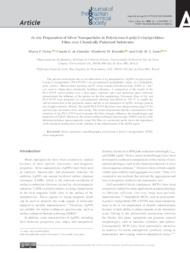In situ preparation of silver nanoparticles in polystyrene-b-poly (2-vinylpyridine) films over chemically patterned substrates.
In situ preparation of silver nanoparticles in polystyrene-b-poly (2-vinylpyridine) films over chemically patterned substrates.
Author(s): VIEIRA, M. F.; ALMEIDA, C. G. de; BRANDAO, H. de M.; IZUMI, C. M. S.
Summary: The present work reports the in situ fabrication of Ag nanoparticles (AgNPs) in polystyreneb-poly(2-vinylpyridine) (PS-b-P2VP) over pre-patterned hydrophobic stripes on a hydrophilic glass surface. Microcontact printing (?CP) using octadecyltrichlorosilane (OTS) as “ink” was used to obtain these chemically modified substrates. A comparison of the results of the PS-b-P2VP self-assembly over a bare glass substrate and a pre-patterned glass substrate demonstrated the influence of the pattern on the film morphology. Polymeric films of Ag+ and PS-b-P2VP were prepared on a pre-patterned substrate and heated at 150 °C to enable the self-reconstruction of the polymeric matrix and the in situ formation of AgNPs (average particle size of approximately 100 nm). The AgNP/PS-b-P2VP thin films were characterized using UV-Vis spectroscopy and atomic force microscopy. The results demonstrate that the concentration of the solutions of Ag+ /PS-b-P2VP used to prepare the films strongly influences the morphologies and dispersion of AgNPs. Moreover, the surface-enhanced Raman spectroscopy (SERS) activity of the fabricated polymer nanocomposites using Nile Blue as a molecular probe shows the importance of the chemical modification of the substrate in the enhancement of the SERS signal.
Publication year: 2025
Types of publication: Journal article
Unit: Embrapa Dairy Cattle
Keywords: Nanoparticles, Nanopartícula, Poliestireno, Vidro hidrofílico
Observation
Some of Embrapa's publications are published as ePub files. To read them, use or download one of the following free software options to your computer or mobile device. Android: Google Play Books; IOS: iBooks; Windows and Linux: Calibre.
Access other publications
Access the Agricultural Research Database (BDPA) to consult Embrapa's full library collection and records.
Visit Embrapa Bookstore to purchase books and other publications sold by Embrapa.

